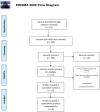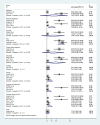Ocular surface manifestations of coronavirus disease 2019 (COVID-19): A systematic review and meta-analysis
- PMID: 33151999
- PMCID: PMC7643964
- DOI: 10.1371/journal.pone.0241661
Ocular surface manifestations of coronavirus disease 2019 (COVID-19): A systematic review and meta-analysis
Abstract
Purpose: This study was performed to determine the occurrence of ocular surface manifestations in patients diagnosed with coronavirus disease 2019 (COVID-19) due to severe acute respiratory syndrome coronavirus 2 (SARS-CoV-2).
Methods: A systematic search of electronic databases i.e. PubMed, Web of Science, CINAHL, OVID and Google scholar was performed using a comprehensive search strategy. The searches were current through 31st May 2020. Pooled data from cross-sectional studies was used for meta-analysis and a narrative synthesis was conducted for studies where a meta-analysis was not feasible.
Results: A total of 16 studies reporting 2347 confirmed COVID-19 cases were included. Pooled data showed that 11.64% of COVID-19 patients had ocular surface manifestations. Ocular pain (31.2%), discharge (19.2%), redness (10.8%), and follicular conjunctivitis (7.7%) were the main features. 6.9% patients with ocular manifestations had severe pneumonia. Viral RNA was detected from the ocular specimens in 3.5% patients.
Conclusion: The most common reported ocular presentations of COVID-19 included ocular pain, redness, discharge, and follicular conjunctivitis. A small proportion of patients had viral RNA in their conjunctival/tear samples. The available studies show significant publication bias and heterogeneity. Prospective studies with methodical collection and data reporting are needed for evaluation of ocular involvement in COVID-19.
Conflict of interest statement
The authors have declared that no competing interests exist.
Figures









References
-
- WHO Timeline—COVID-19. [cited 20 Jun 2020]. Available: https://www.who.int/news-room/detail/27-04-2020-who-timeline—covid-19
-
- CDC. Coronavirus Disease 2019 (COVID-19). In: Centers for Disease Control and Prevention [Internet]. 11 Feb 2020 [cited 20 Jun 2020]. Available: https://www.cdc.gov/coronavirus/2019-ncov/index.html
Publication types
MeSH terms
LinkOut - more resources
Full Text Sources
Medical
Miscellaneous

